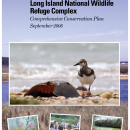What We Do
Wildlife conservation is at the heart of the National Wildlife Refuge System. It drives everything on U.S. Fish and Wildlife Service lands and waters managed within the Refuge System, from the purposes for which a national wildlife refuge national wildlife refuge
A national wildlife refuge is typically a contiguous area of land and water managed by the U.S. Fish and Wildlife Service for the conservation and, where appropriate, restoration of fish, wildlife and plant resources and their habitats for the benefit of present and future generations of Americans.
Learn more about national wildlife refuge is established to the recreational activities offered to the resource management tools used. Using conservation best practices, the Refuge System manages Service lands and waters to help ensure the survival of native wildlife species.
Refuges deploy a host of scientifically sound management tools to address biological challenges. These tools span active water management to wilderness character monitoring, all aimed at ensuring a balanced conservation approach to benefit both wildlife and people. At this field station our conservation tool box includes:
Beach Nesting & Bird Monitoring
Seasonal interns are hired each year to assist with the high volume of beach nesting bird monitoring during the spring and summer months. In addition to the piping plover exclosures, interns install tern shelters. These allow the young terns to escape predators. Interns also monitor bird locations and species numbers daily. This information is used to estimate regional numbers of these federally and state threatened and endangered species.
Invasive Species
Refuge staff are founding members of the Long Island Invasive Species Management Area. Networking with other members and attending periodic public meetings has helped us realize the most problematic species, develop mapping standards, prioritize treatment regimens and prepare outreach materials.
Trapping
Trapping is a wildlife management tool used on some national wildlife refuges. Trapping may be used to protect endangered and threatened species or migratory birds or to control certain wildlife populations. The U.S. Fish and Wildlife Service also views trapping as a legitimate recreational and economic activity when there are harvestable surpluses of fur-bearing mammals. Outside of Alaska, refuges that permit trapping as a recreational use may require trappers to obtain a refuge special use permit. Signs are posted on refuges where trapping occurs. Contact the refuge manager for specific regulations.
Management and Conservation
Management Goals
Refuge management goals are:
- Provide and manage a diversity of high quality habitats to support breeding, migrating and/or wintering birds, threatened & endangered species, and fish.
- Maintain high quality habitats for all native wildlife and plant species.
- Establish and maintain partnerships to benefit wildlife for present and future generations
Law Enforcement
The mission of the National Wildlife Refuge System Law Enforcement program is:
"Through education and enforcement we protect our employees, volunteers, and visitors; safeguard the public’s investment in facilities and equipment; and protect the integrity of the habitat and the wildlife resources of the National trust resource which is the 150 million acre National Wildlife Refuge System.”
Laws and Regulations
To protect the natural resources of the refuge and to provide all visitors with a safe and enjoyable wildlife experience, please observe all refuge signs and regulations in handouts and brochures.
